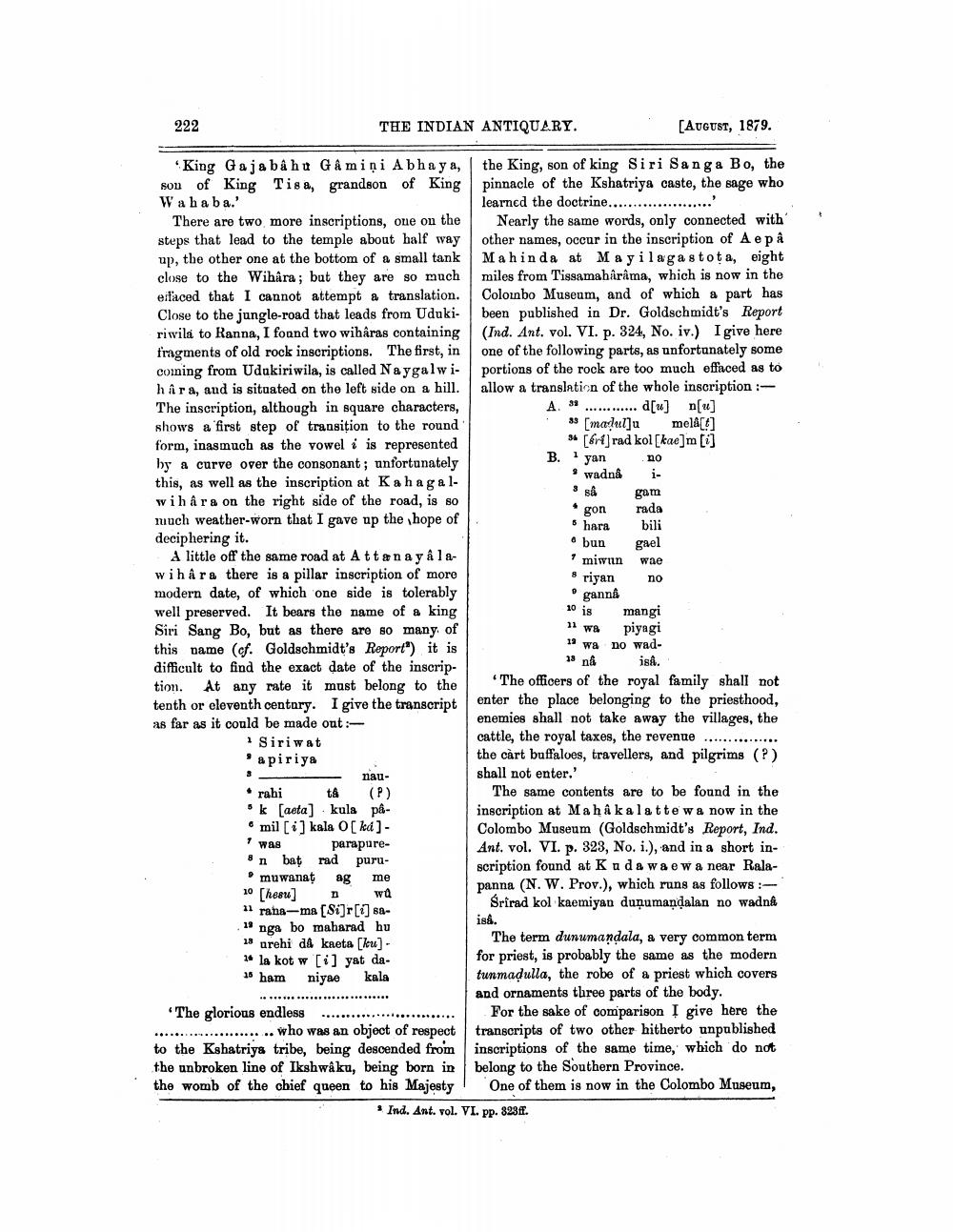________________
222
King Gajabahu Gâmiņi Abhaya, son of King Tisa, grandson of King Wahaba.'
THE INDIAN ANTIQUARY.
There are two more inscriptions, one on the steps that lead to the temple about half way up, the other one at the bottom of a small tank close to the Wihâra; but they are so much efaced that I cannot attempt a translation. Close to the jungle-road that leads from Udukiriwila to Ranna, I found two wihâras containing fragments of old rock inscriptions. The first, in coming from Udukiriwila, is called Naygalwihara, and is situated on the left side on a hill. The inscription, although in square characters, shows a first step of transition to the round" form, inasmuch as the vowel is represented by a curve over the consonant; unfortunately this, as well as the inscription at Kahagalwihara on the right side of the road, is so much weather-worn that I gave up the hope of deciphering it.
A little off the same road at Attanayâlawihara there is a pillar inscription of more modern date, of which one side is tolerably well preserved. It bears the name of a king Siri Sang Bo, but as there are so many of this name (cf. Goldschmidt's Report") it is difficult to find the exact date of the inscription. At any rate it must belong to the tenth or eleventh century. I give the transcript as far as it could be made out:
1 Siriwat "apiriya
nau
• rahi tâ (P) k [aeta] kula pâmil [i] kala O[ká]7 was
parapure8 n bat rad puru⚫ muwanat ag me 10 [hesu] wa 1 raha-ma [Si]r[i] sa19 nga bo maharad hu
n
18 urehi da kaeta [ku]
[AUGUST, 1879.
the King, son of king Siri Sanga Bo, the pinnacle of the Kshatriya caste, the sage who learned the doctrine...
1 la kot w [i] yat da15 ham niyae kala
Nearly the same words, only connected with' other names, occur in the inscription of A e pâ Mahinda at Mayilagastota, eight miles from Tissamahârâma, which is now in the Colombo Museum, and of which a part has been published in Dr. Goldschmidt's Report (Ind. Ant. vol. VI. p. 324, No. iv.) I give here one of the following parts, as unfortunately some portions of the rock are too much effaced as to allow a translation of the whole inscription :A. 39 d[u] [u] 33 [malul]u melâ[?]
************
3 [64] rad kol [kae]m [i]
1 yan
B.
* wadna 3 så
.no
i
gam rada
bili
"The glorious endless
... who was an object of respect to the Kshatriya tribe, being descended from the unbroken line of Ikshwâku, being born in the womb of the chief queen to his Majesty Ind. Ant. vol. VI.
pp.
gon 5 hara
• bun
7 miwun 8 riyan gannâ 10 is
mangi piyagi
11 W&
19 wa no wad13 nå isâ.
gael wae
no
'The officers of the royal family shall not enter the place belonging to the priesthood, enemies shall not take away the villages, the cattle, the royal taxes, the revenue
the cart buffaloes, travellers, and pilgrims (?) shall not enter.'
The same contents are to be found in the inscription at Mahakalatte wa now in the Colombo Museum (Goldschmidt's Report, Ind. Ant. vol. VI. p. 323, No. i.), and in a short inscription found at Kuda waewa near Ralapanna (N. W. Prov.), which runs as follows:Śrirad kol kaemiyan duņumaṇḍalan no wadnâ
isâ.
The term dunumandala, a very common term for priest, is probably the same as the modern tunmaḍulla, the robe of a priest which covers and ornaments three parts of the body.
For the sake of comparison I give here the transcripts of two other hitherto unpublished inscriptions of the same time, which do not belong to the Southern Province.
One of them is now in the Colombo Museum,
323.




